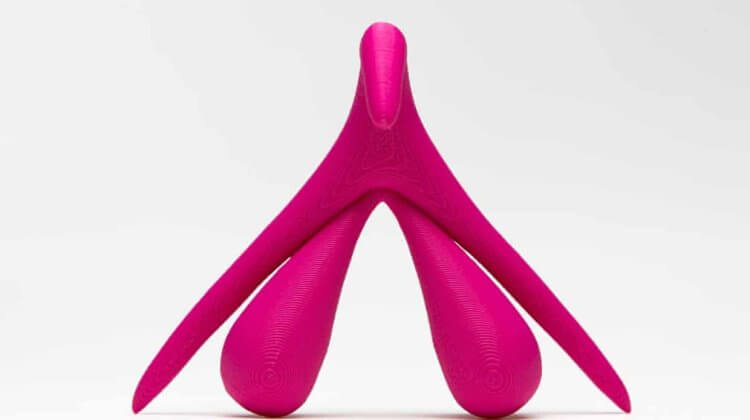
Anabolic steroids can cause virilization or masculinization in women. That is, they might cause the development of male characteristics. This includes the growth of excess hair in a male-like pattern, deepening of the voice, but also growth of the clitoris—clitoromegaly. Women who want to inform themselves about these side effects are often left with anecdotes, as easily accessible information about these effects is scarce. This is unfortunate and unnecessary, as quite some data is available about this in the scientific literature. This scarcity of information was one of the main reasons why I decided to dedicate a chapter about anabolic steroid use in women in Book on Steroids.
For this article, I’ll cover clitoris growth or enlargement, also known as clitoromegaly. What got me typing this article was the following passage I read in a recent publication about women’s experiences of using anabolic steroids [1]:
“But nothing happened. So then I thought, well, I can just keep going. Every time I had the injection, I felt such anxiety in my body. I repeatedly checked my clitoris, I searched on Google and read about clitoris enlargement about 100 times.”
This highlights how this side effect can worry a woman using anabolic steroids and that information about it, accessible through the internet, is welcomed.
The clitoris grows under the influence of androgens
Clitoromegaly can be observed in some women in which there’s an excess exposure of androgens, such as can be the case with polycystic ovarian syndrome (PCOS). Women with PCOS commonly have a mild to moderate increase in circulating androgens. While overt growth of the clitoris is rare in PCOS, the mild to moderate exposure of time is apparently enough to cause a small amount of growth in these women (we’re talking a ~2 mm increase in length-wise width of the clitoris) [2].

Image taken from Iezzi et al. [3]
Clitoromegaly can also be observed in other congenital or acquired conditions in which there is excess androgen activity. It is, therefore, clear that androgens can make the clitoris grow. And so do exogenously administered anabolic steroids. This is consistently observed in female-to-male transsexuals who are treated with testosterone [4, 5].
Growth of the clitoris depends on dosage and duration
When looking at the scientific literature, it seems likely that growth of the clitoris depends on dosage and duration of anabolic steroid use. This makes quite some sense. In one trial, female-to-male transsexual patients received up to 200 mg testosterone cypionate biweekly [4]. (Although some, against medical advice, administered dosages up to 400 mg weekly.) The stretched clitoral length was measured (length of hood in the picture above), and was 1.4 cm at baseline. This increased to just over 3 cm within the first 4 months of treatment, and gradually increased further till it plateaued after about a year at around 4.5 cm. In one of the patients it had increased to 6.0 cm. Another trial, also with female-to-male transsexual patients treated with testosterone undecnoate, didn’t assess clitoral growth over time, but measured a mean length of 4 cm as well after a year of treatment [5]. Yet another trial in female-to-male transsexual patients, titrated testosterone dosage dependent on testosterone levels which resulted in a 1,000 mg testosterone undecanoate injection once every 10 to 14 weeks [6]. Clitoral length was 2 cm at baseline and was subsequently recorded at the 3th, 6th, 12th and 24th month of treatment. At these points in time, it had increased to 3.2, 3.3, 3.6, and 3.8 cm in length.
Collectively these findings indicate that the clitoris length can grow up to around 4 cm in length on average by testosterone administration, with a significant amount of growth already occurring within 3 months. A mean dosage of around 100 mg esterified testosterone is clearly enough to induce it. But what about lower dosages? In a trial by Bhasin’s group, hysterectomized women were randomized to placebo, 3, 6.25, 12.5 or 25 mg testosterone enanthate weekly for 24 weeks [7]. This resulted in mean on-treatment nadir testosterone concentrations of 19, 78, 102, 128 and 210 ng/dL at the 0, 3, 6.25, 12.5 and 25-mg doses, respectively. Thus, even the 3 mg group had testosterone concentrations slightly above the upper reference limit for women (62.5 ng/dL during the luteal phase) [8].
No effect was observed on clitoral length and width. Additionally, no clitoromegaly was reported by any of the subjects. While this doesn’t exclude an effect of these dosages on clitoral size on every individual, it does suggest the likelihood is clearly and significantly less than the higher dosages used in trials with female-to-male transsexual patients. As such, there appears to be a threshold between 25 mg and 100 mg testosterone weekly that will induce clitoral growth in most. Moreover, this doesn’t mean that 25 mg weekly will never induce clitoromegaly. The amount of time a dosage is taken matters too. While 24 weeks is undoubtedly long, and many women who use AAS to enhance their physiques use these drugs for shorter periods of time, it doesn’t say much about longer periods of time. Especially in the light of patients with PCOS who have lower testosterone concentrations than the 25 mg group, yet do demonstrate small clitoral growth in general as mentioned earlier.
Data is lacking on other anabolic steroids than testosterone, which makes it hard to say if one is “better” than the other in this regard. It seems likely the potency to activate the androgen receptor in the clitoris and surrounding tissue dictates its potency for growth of the clitoris. One could thereby speculate about the effect of 5α-reductase on this—the enzyme responsible for conversion of testosterone into the more potent androgen dihydrotestosterone (DHT). The enzyme thereby amplifies the effect of testosterone in tissues expressing it. Several cell types of the vagina express this enzyme [9], thus, testosterone’s effect could be amplified here. Resultantly, one could argue that anabolic steroids that do not undergo this modification in the human body, have a relatively more favorable effect than testosterone. Notably, nandrolone gets converted to a less potent androgen by 5α-reductase, namely dihydronandrolone [10]. Thus, nandrolone’s effect might be diminished here. When looking at commonly used anabolic steroids, only testosterone and nandrolone are affected by 5α-reductase.
| Compound | Can be 5α-reduced in the body? |
| Testosterone | Yes, to a more potent androgen (DHT) |
| Nandrolone | Yes, to a less potent androgen (DHN) [10] |
| Boldenone | No, not significantly 5α-reduced in the body [11, 12] |
| Trenbolone | No, not significantly 5α-reduced in the body [11] |
| Methandienone | No, not significantly 5α-reduced in the body [11] |
| Turinabol | No, not significantly 5α-reduced in the body [11] |
| Fluoxymesterone | No, not significantly 5α-reduced in the body [11] |
| Methenolone | No, already 5α-reduced |
| Drostanolone | No, already 5α-reduced |
| Stanozolol | No, already 5α-reduced |
| Oxandrolone | No, already 5α-reduced |
| Oxymetholone | No, already 5α-reduced |
Conclusion
Anabolic steroid use can lead to growth of the clitoris. Dosages of testosterone enanthate in the range of 100 mg weekly undoubtedly lead to growth of the clitoris in a significant number of women within weeks or at least within 3 months. Lower dosages, up to 25 mg weekly, appear relatively safe with regard to this specific side effect for subchronic amounts of time (24 weeks). It’s likely that prolonged exposure, even with lower dosages, might lead to some clitoris growth, as evidenced by medical conditions in which androgen activity is—compared to 25 mg testosterone enanthate weekly—mildly elevated.
It seems prudent that, when this side effect is to be avoided, weekly monitoring is performed. It’s important that the size of the clitoris is assessed when not in a sexually aroused state, as this transiently increases the size of the clitoris. When true growth has occurred, anabolic steroid use is to be ceased immediately—true growth is irreversible. Be thoughtful about anabolic steroids with relatively long half-lives: their androgen effects will continue for some time after cessation, of course.
References
- Börjesson, Annica, et al. “Women’s Experiences of Using Anabolic Androgenic Steroids.” Frontiers in Sports and Active Living 3 (2021).
- Köşüş, A., et al. “Clitoral and labial sizes in women wıth PCOS.” Journal of Obstetrics and Gynaecology 36.1 (2016): 97-101.
- Iezzi, Maria L., et al. “Clitoromegaly in childhood and adolescence: behind one clinical sign, a clinical sea.” Sexual Development 12.4 (2018): 163-174.
- Meyer, Walter J., et al. “Physical and hormonal evaluation of transsexual patients: a longitudinal study.” Archives of sexual behavior 15.2 (1986): 121-138.
- Mueller, Andreas, et al. “Long-term administration of testosterone undecanoate every 3 months for testosterone supplementation in female-to-male transsexuals.” The Journal of Clinical Endocrinology & Metabolism 92.9 (2007): 3470-3475.
- Fisher, Alessandra D., et al. “Cross-sex hormone treatment and psychobiological changes in transsexual persons: two-year follow-up data.” The Journal of Clinical Endocrinology & Metabolism 101.11 (2016): 4260-4269.
- Huang, Grace, et al. “Testosterone dose-response relationships in hysterectomized women with and without oophorectomy: effects on sexual function, body composition, muscle performance and physical function in a randomized trial.” Menopause (New York, NY) 21.6 (2014): 612.
- Coviello, A. D., K. P. Nelson, and S. Bhasin. “Reference ranges for circulating testosterone in the follicular and luteal phases of the menstrual cycle in a healthy, community-based sample of women in the Framingham Heart Study.” Endocrine Reviews 33 (2012).
- Bertin, Jonathan, et al. “Localization of the Androgen‐Synthesizing Enzymes, Androgen Receptor, and Sex Steroids in the Vagina: Possible Implications for the Treatment of Postmenopausal Sexual Dysfunction.” The journal of sexual medicine 11.8 (2014): 1949-1961.
- Bergink, E. W., et al. “Comparison of the receptor binding properties of nandrolone and testosterone under in vitro and in vivo conditions.” Journal of steroid biochemistry 22.6 (1985): 831-836.
- Schänzer, Wilhelm. “Metabolism of anabolic androgenic steroids.” Clinical chemistry 42.7 (1996): 1001-1020.
- Schänzer, W., and M. Donike. “Metabolism of boldenone in man: gas chromatographic/mass spectrometric identification of urinary excreted metabolites and determination of excretion rates.” Biological mass spectrometry 21.1 (1992): 3-16.
About the author
Peter Bond is a scientific author with publications on anabolic steroids, the regulation of an important molecular pathway of muscle growth (mTORC1), and the dietary supplement phosphatidic acid. He is the author of several books in Dutch and English, including Book on Steroids and Bond's Dietary Supplements.


Leave a Reply
You must be logged in to post a comment.